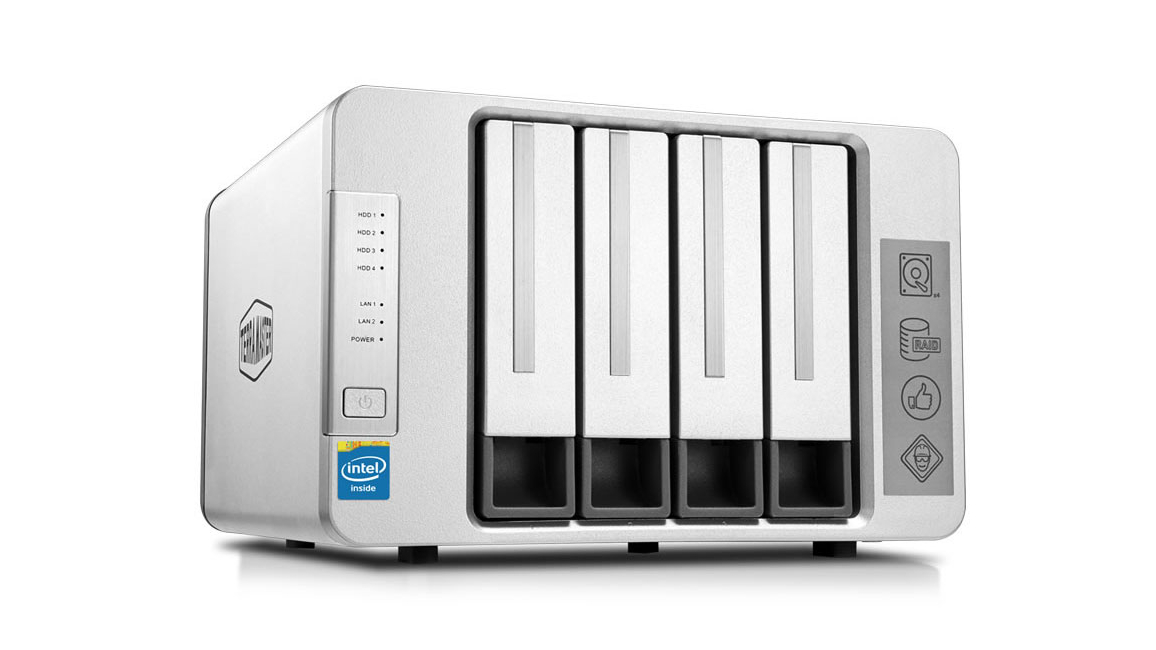Why you can trust TechRadar
Performance
File serving performance on this system is entirely dependent on having a managed switch with the functionality to create channel bonding. Without that critical functionality the best speed you’ll see, almost irrespective of the drives in use, are 115MB/s reading and 110MB/s writing.
That’s the effective limits of Gigabit Ethernet, not the NAS box.
With both Ethernet ports connected to a suitable switch, those scores can be doubled. But unless any connecting computers also have dual LAN networking, the extra performance will be aggregated across multiple users.

For those wanting to use both Ethernet ports simultaneously, you have some interesting options including load balancing over two switches, Dynamic Link Aggregation (802.3ad), Balance XOR and an automatic fail-over mode.
Wi-Fi isn’t an inherent capability, but you can insert a suitable USB Wi-Fi adapter into one of the available ports and establish a direct link through that.
Accessing the F4-420 as a file server elicits a suitably snappy response. Monitoring the performance logs while intentionally flooding the bandwidth of both LAN adapters shows that even the most intense transfers won’t overload the quad-core CPU.
Which begs the obvious question, again: what to do with those spare CPU cycles?

In use
Getting the review unit operational wasn’t as slick and painless as it should have been. Many of the issues here revolved around the TNAS software that TerraMaster uses to initialize the device and then install its TOS 3.1 operating system.
While possibly a temporary glitch, the download speed of the TerraMaster website was disappointingly slow. It took over two hours to download the required files, disturbingly.
When we’d finally got it downloaded, the TNAS PC app didn’t include a proper installer, and just appeared to be a collection of VB code with an obsolete file manifest.
Our first attempt to run this software failed – mainly because it made assumptions about the .NET installation on the client PC that wasn’t guaranteed or even tested, causing it to crash.
I’m sure a skilled IT department would have no problems resolving the TNAS application issues, but they might easily frustrate a less capable user.
As an alternative TerraMaster does offer a 3.1 Beta release that at least had an installable executable, but this too crashed on a Windows 7 PC.
Eventually, we got that to work on a Windows 10 machine that luckily had the components that the software was expecting, and we could then install TOS 3.1 on the F4-420.
Once we’d jumped through those hoops and got the drives and TOS 3.1 working together, this NAS box worked reasonably well, although it isn’t anything special from a functionality standpoint.
The overall TOS operating system experience has moved on a little since we reviewed the F2-220, with some minor tweaks made, but it isn’t dramatically different.
While the interface revision is clean and fairly logical, the GUI designer missed the point that when you navigate down through a tree, you might want to reverse back, too.
Along with TOS 3.1 inherent functionality, TerraMaster offers a modest selection of installable apps. They number just 20, which is one more than was listed under TOS 3.0.

In the collection are the hardy perennials of NAS box deployment, like MySQL Server, Plex Media Server, Sugar CRM, WordPress and Apache Tomcat. Other tools that are likely to be popular are the iTunes server and a Dropbox sync tool.
One useful enhancement is the inclusion of rclone, a tool that allows other cloud services to be synced such as Google and Amazon S3. Or at least that’s what the description implied.
We could only find the Google Drive option in the app, and we couldn’t get that to work. As with many of the third-party tools, there are no help files or notes you can refer to for this app.
If you want rclone functionality to work as intended we’d recommend using your Debian Linux skills to install the latest version manually. Then configure it via a shell, and not the provided clunky web interface.
Some functionality is pre-installed along with the limited installable applications. Those needing DLNA, Time Machine, FTP and Rsync merely need to configure these services through the control panel. These services, in general, work better than the installable apps and do have a little documentation.
The F2-220 infamously didn’t have proper power management for its host drives, but this equipment and OS does at least have that feature.
Overall, the software has had a few tweaks and enhancements, but not the love and attention that it truly needs.
The frustration here is that there is very little wrong with the TerraMaster hardware. It just needs a better software platform to exploit it fully, and an ongoing development cycle to enhance the user experience.

Final verdict
A comparable product from market-leading Synology is the DS418. It costs less, has around 100 applications to install, and a DSM operating system that has been in development for over a decade.
Under those circumstances, it’s hard to see why the TerraMaster F4-420 would be chosen over the much more polished Synology DS418, or the 10GbE-capable QNAP TS-431X-2G.
- These are the best NAS devices
Mark is an expert on 3D printers, drones and phones. He also covers storage, including SSDs, NAS drives and portable hard drives. He started writing in 1986 and has contributed to MicroMart, PC Format, 3D World, among others.

